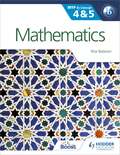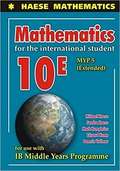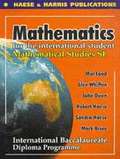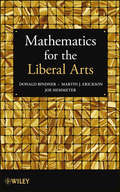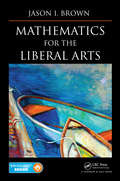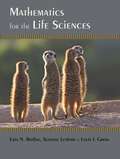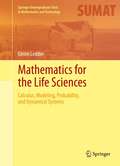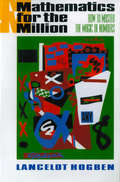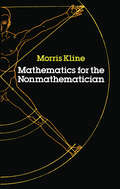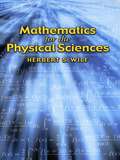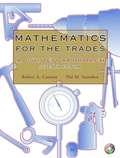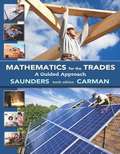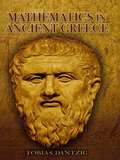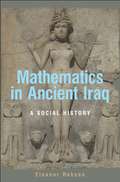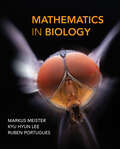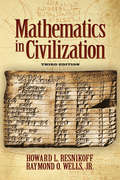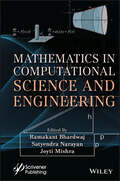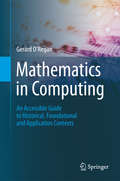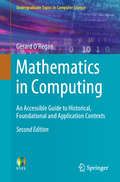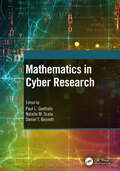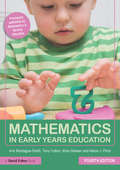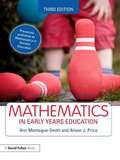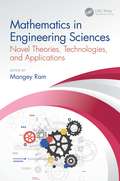- Table View
- List View
Mathematics for the IB MYP 4 & 5: By Concept (MYP By Concept)
by Rita BatesonExam Board: IBLevel: MYPSubject: MathematicsFirst Teaching: September 2016First Exam: June 2017The only series for MYP 4 and 5 developed in cooperation with the International Baccalaureate (IB)Develop your skills to become an inquiring learner; ensure you navigate the MYP framework with confidence using a concept-driven and assessment-focused approach to Mathematics presented in global contexts.- Develop conceptual understanding with key MYP concepts and related concepts at the heart of each chapter.- Learn by asking questions with a statement of inquiry in each chapter. - Prepare for every aspect of assessment using support and tasks designed by experienced educators.- Understand how to extend your learning through research projects and interdisciplinary opportunities.Feel confident that you cover the whole framework with standard and extended mathematics included - and Extended clearly signposted.This title is also available in two digital formats via Dynamic Learning. Find out more by clicking on the links at the top of the page.A proof of the first 6 Chapters of the book is now available as an eInspection copy, by clicking the eInspection copy button to the left. Rita Bateson was, until very recently, the Curriculum Manager for MYP Mathematics and Sciences at the International Baccalaureate® (IB) and continues to be involved in curriculum review. She is an experienced teacher of MYP and DP Mathematics and Sciences, and is Head of Mathematics in her current school. She has taught in many international schools in Europe as well as North America. Her interest include overcoming mathematics anxiety in pupils and STEM education. She is also the co-author of MYP by Concept 1-3 Mathematics, with Irina Amlin.
Mathematics for the International Student 10E (MYP 5 Extended)
by Edward Kemp Sandra Haese Michael Haese Mark Humphries Pamela VollmarThis book may also be used as a general textbook at about 10th Grade level in classes where students complete a rigorous course in preparation for the study of mathematics at a high level in their final two years of high school. We have developed this book independently of the International Baccalaureate Organization (IBO) in consultation with experienced teachers of IB Mathematics
Mathematics for the International Student: Mathematical Studies Standard Level
by John Owen Mal Coad Glen Whifren Robert Haese Sandra Haese Mark BruceMathematics for the International Student: Mathematical Studies SL has been written to embrace the syllabus for the new two-year Mathematical Studies SL Course, which is one of the courses of study in the International Baccalaureate Diploma Programme.
Mathematics for the Liberal Arts
by Martin J. Erickson Donald Bindner Joe HemmeterPresents a clear bridge between mathematics and the liberal arts Mathematics for the Liberal Arts provides a comprehensible and precise introduction to modern mathematics intertwined with the history of mathematical discoveries. The book discusses mathematical ideas in the context of the unfolding story of human thought and highlights the application of mathematics in everyday life. Divided into two parts, Mathematics for the Liberal Arts first traces the history of mathematics from the ancient world to the Middle Ages, then moves on to the Renaissance and finishes with the development of modern mathematics. In the second part, the book explores major topics of calculus and number theory, including problem-solving techniques and real-world applications. This book emphasizes learning through doing, presents a practical approach, and features: A detailed explanation of why mathematical principles are true and how the mathematical processes work Numerous figures and diagrams as well as hundreds of worked examples and exercises, aiding readers to further visualize the presented concepts Various real-world practical applications of mathematics, including error-correcting codes and the space shuttle program Vignette biographies of renowned mathematicians Appendices with solutions to selected exercises and suggestions for further reading Mathematics for the Liberal Arts is an excellent introduction to the history and concepts of mathematics for undergraduate liberal arts students and readers in non-scientific fields wishing to gain a better understanding of mathematics and mathematical problem-solving skills.
Mathematics for the Liberal Arts
by Jason I. BrownThis textbook teaches everyday mathematics topics to non-math majors at the undergraduate level. Through numerous examples and more than 600 exercises, students learn how to use math seamlessly in a variety of practical areas, from conversion factors, statistics, visualization, money, and risk to games, art, music, and humor. The text develops a logical, real-world approach to data and reasoning. Real-life stories in each chapter capture students' interest and motivate them to work through the math. Ancillaries are available on the author's website.
Mathematics for the Liberal Arts
by Jason I. BrownThis textbook teaches everyday mathematics topics to non-math majors at the undergraduate level. Through numerous examples and more than 600 exercises, students learn how to use math seamlessly in a variety of practical areas, from conversion factors, statistics, visualization, money, and risk to games, art, music, and humor. The text develops a logical, real-world approach to data and reasoning. Real-life stories in each chapter capture students' interest and motivate them to work through the math. Ancillaries are available on the author's website.
Mathematics for the Life Sciences
by Louis J. Gross Suzanne Lenhart Erin N. BodineAn accessible undergraduate textbook on the essential math concepts used in the life sciencesThe life sciences deal with a vast array of problems at different spatial, temporal, and organizational scales. The mathematics necessary to describe, model, and analyze these problems is similarly diverse, incorporating quantitative techniques that are rarely taught in standard undergraduate courses. This textbook provides an accessible introduction to these critical mathematical concepts, linking them to biological observation and theory while also presenting the computational tools needed to address problems not readily investigated using mathematics alone.Proven in the classroom and requiring only a background in high school math, Mathematics for the Life Sciences doesn't just focus on calculus as do most other textbooks on the subject. It covers deterministic methods and those that incorporate uncertainty, problems in discrete and continuous time, probability, graphing and data analysis, matrix modeling, difference equations, differential equations, and much more. The book uses MATLAB throughout, explaining how to use it, write code, and connect models to data in examples chosen from across the life sciences.Provides undergraduate life science students with a succinct overview of major mathematical concepts that are essential for modern biologyCovers all the major quantitative concepts that national reports have identified as the ideal components of an entry-level course for life science studentsProvides good background for the MCAT, which now includes data-based and statistical reasoningExplicitly links data and math modelingIncludes end-of-chapter homework problems, end-of-unit student projects, and select answers to homework problemsUses MATLAB throughout, and MATLAB m-files with an R supplement are available onlinePrepares students to read with comprehension the growing quantitative literature across the life sciencesA solutions manual for professors and an illustration package is available
Mathematics for the Life Sciences: Calculus, Modeling, Probability, and Dynamical Systems
by Glenn LedderMathematics for the Life Sciences provides present and future biologists with the mathematical concepts and tools needed to understand and use mathematical models and read advanced mathematical biology books. It presents mathematics in biological contexts, focusing on the central mathematical ideas, and providing detailed explanations. The author assumes no mathematics background beyond algebra and precalculus. Calculus is presented as a one-chapter primer that is suitable for readers who have not studied the subject before, as well as readers who have taken a calculus course and need a review. This primer is followed by a novel chapter on mathematical modeling that begins with discussions of biological data and the basic principles of modeling. The remainder of the chapter introduces the reader to topics in mechanistic modeling (deriving models from biological assumptions) and empirical modeling (using data to parameterize and select models). The modeling chapter contains a thorough treatment of key ideas and techniques that are often neglected in mathematics books. It also provides the reader with a sophisticated viewpoint and the essential background needed to make full use of the remainder of the book, which includes two chapters on probability and its applications to inferential statistics and three chapters on discrete and continuous dynamical systems. The biological content of the book is self-contained and includes many basic biology topics such as the genetic code, Mendelian genetics, population dynamics, predator-prey relationships, epidemiology, and immunology. The large number of problem sets include some drill problems along with a large number of case studies. The latter are divided into step-by-step problems and sorted into the appropriate section, allowing readers to gradually develop complete investigations from understanding the biological assumptions to a complete analysis.
Mathematics for the Million: How to Master the Magic of Numbers
by Lancelot Hogben"It makes alive the contents of the elements of mathematics."--Albert Einstein Taking only the most elementary knowledge for granted, Lancelot Hogben leads readers of this famous book through the whole course from simple arithmetic to calculus. His illuminating explanation is addressed to the person who wants to understand the place of mathematics in modern civilization but who has been intimidated by its supposed difficulty. Mathematics is the language of size, shape, and order--a language Hogben shows one can both master and enjoy.
Mathematics for the Nonmathematician
by Morris KlinePractical, scientific, philosophical, and artistic problems have caused men to investigate mathematics. But there is one other motive which is as strong as any of these--the search for beauty. Mathematics is an art, and as such affords the pleasures which all the arts afford." In this erudite, entertaining college-level text, Morris Kline, Professor Emeritus of Mathematics at New York University, provides the liberal arts student with a detailed treatment of mathematics in a cultural and historical context. The book can also act as a self-study vehicle for advanced high school students and laymen. Professor Kline begins with an overview, tracing the development of mathematics to the ancient Greeks, and following its evolution through the Middle Ages and the Renaissance to the present day. Subsequent chapters focus on specific subject areas, such as "Logic and Mathematics," "Number: The Fundamental Concept," "Parametric Equations and Curvilinear Motion," "The Differential Calculus," and "The Theory of Probability." Each of these sections offers a step-by-step explanation of concepts and then tests the student's understanding with exercises and problems. At the same time, these concepts are linked to pure and applied science, engineering, philosophy, the social sciences or even the arts.In one section, Professor Kline discusses non-Euclidean geometry, ranking it with evolution as one of the "two concepts which have most profoundly revolutionized our intellectual development since the nineteenth century." His lucid treatment of this difficult subject starts in the 1800s with the pioneering work of Gauss, Lobachevsky, Bolyai and Riemann, and moves forward to the theory of relativity, explaining the mathematical, scientific and philosophical aspects of this pivotal breakthrough. Mathematics for the Nonmathematician exemplifies Morris Kline's rare ability to simplify complex subjects for the nonspecialist.
Mathematics for the Physical Sciences
by Herbert S WilfThis book offers advanced undergraduates and graduate students in physics, engineering, and other natural sciences a solid foundation in several fields of mathematics. Clear and well-written, it assumes a previous knowledge of the theory of functions of real and complex variables, and is ideal for classroom use, self-study, or as a supplementary text. Starting with vector spaces and matrices, the text proceeds to orthogonal functions; the roots of polynomial equations; asymptotic expansions; ordinary differential equations; conformal mapping; and extremum problems. Each chapter goes straight to the heart of the matter, developing subjects just far enough so that students can easily make the appropriate applications. Exercises at the end of each chapter, along with solutions at the back of the book, afford further opportunities for reinforcement. Discussions of numerical methods are oriented toward computer use, and they bridge the gap between the "there exists" perspective of pure mathematicians and the "find it to three decimal places" mentality of engineers. Each chapter features a separate bibliography.
Mathematics for the Trades: A Guided Approach (7th Edition)
by Robert A. Carman Hal M. SaundersThis book provides the practical mathematics skills needed in a wide variety of trade and technical areas, including electronics, auto mechanics, construction trades and many other occupations.
Mathematics for the Trades: A Guided Approach (Tenth Edition)
by Robert A. Carman Hal M. SaundersMathematics for the Trades: A Guided Approach provides the practical mathematics skills needed in a wide variety of trade, technical, and other occupational areas, including plumbing, automotive, electrical and construction trades, machine technology, landscaping, HVAC, allied health, and many more. <P><P>It is especially intended for students who find math challenging and for adults who have been out of school for a time. This text assists students by providing a direct, practical approach that emphasizes careful, complete explanations and actual on-the-job applications.
Mathematics in Ancient Egypt
by Annette ImhausenMathematics in Ancient Egypt traces the development of Egyptian mathematics, from the end of the fourth millennium BC--and the earliest hints of writing and number notation--to the end of the pharaonic period in Greco-Roman times. Drawing from mathematical texts, architectural drawings, administrative documents, and other sources, Annette Imhausen surveys three thousand years of Egyptian history to present an integrated picture of theoretical mathematics in relation to the daily practices of Egyptian life and social structures.Imhausen shows that from the earliest beginnings, pharaonic civilization used numerical techniques to efficiently control and use their material resources and labor. Even during the Old Kingdom, a variety of metrological systems had already been devised. By the Middle Kingdom, procedures had been established to teach mathematical techniques to scribes in order to make them proficient administrators for their king. Imhausen looks at counterparts to the notation of zero, suggests an explanation for the evolution of unit fractions, and analyzes concepts of arithmetic techniques. She draws connections and comparisons to Mesopotamian mathematics, examines which individuals in Egyptian society held mathematical knowledge, and considers which scribes were trained in mathematical ideas and why. Of interest to historians of mathematics, mathematicians, Egyptologists, and all those curious about Egyptian culture, Mathematics in Ancient Egypt sheds new light on a civilization's unique mathematical evolution.
Mathematics in Ancient Greece (Dover Books on Mathematics)
by Tobias DantzigMore than a history of mathematics, this lively book traces mathematical ideas and processes to their sources, stressing the methods used by the masters of the ancient world. Author Tobias Dantzig portrays the human story behind mathematics, showing how flashes of insight in the minds of certain gifted individuals helped mathematics take enormous forward strides. Dantzig demonstrates how the Greeks organized their precursors' melange of geometric maxims into an elegantly abstract deductive system. He also explains the ways in which some of the famous mathematical brainteasers of antiquity led to the development of whole new branches of mathematics.A book that will both instruct and delight the mathematically minded, this volume is also a treat for readers interested in the history of science. Students and teachers of mathematics will particularly appreciate its unusual combination of human interest and sound scholarship.
Mathematics in Ancient Iraq: A Social History
by Eleanor RobsonThis monumental book traces the origins and development of mathematics in the ancient Middle East, from its earliest beginnings in the fourth millennium BCE to the end of indigenous intellectual culture in the second century BCE when cuneiform writing was gradually abandoned. Eleanor Robson offers a history like no other, examining ancient mathematics within its broader social, political, economic, and religious contexts, and showing that mathematics was not just an abstract discipline for elites but a key component in ordering society and understanding the world. The region of modern-day Iraq is uniquely rich in evidence for ancient mathematics because its prehistoric inhabitants wrote on clay tablets, many hundreds of thousands of which have been archaeologically excavated, deciphered, and translated. Drawing from these and a wealth of other textual and archaeological evidence, Robson gives an extraordinarily detailed picture of how mathematical ideas and practices were conceived, used, and taught during this period. She challenges the prevailing view that they were merely the simplistic precursors of classical Greek mathematics, and explains how the prevailing view came to be. Robson reveals the true sophistication and beauty of ancient Middle Eastern mathematics as it evolved over three thousand years, from the earliest beginnings of recorded accounting to complex mathematical astronomy. Every chapter provides detailed information on sources, and the book includes an appendix on all mathematical cuneiform tablets published before 2007.
Mathematics in Biology
by Markus Meister Kyu Hyun Lee Ruben PortuguesA concise but rigorous textbook for advanced undergraduate and graduate students across the biological sciences that provides a foundation for understanding the methods used in quantitative biology.Biology has turned into a quantitative science. The core problems in the life sciences today involve complex systems that require mathematical expression, yet most biologists are untrained in this dimension of the discipline. Bridging that gap, this practical textbook equips students to integrate advanced mathematical concepts with their biological education. Mathematics in Biology covers three broad subjects—linear algebra, probability and statistics, and dynamical systems—each treated at three levels: basic principles, advanced topics, and applications. Motivations and examples are drawn from diverse areas of study, while end-of-chapter exercises encourage creative applications. Based on nearly two decades of teaching at Harvard and Caltech, this rigorous but concise text provides an essential foundation for understanding the methods used in quantitative biology. • Proven in the classroom• Suitable for advanced undergraduate and graduate students across the biological sciences• Offers accompanying online materials including code and solved exercises
Mathematics in Civilization, Third Edition (Dover Books on Mathematics)
by Raymond O. Wells Jr. Howard L. ResnikoffSpace flight, computers, lasers, and information technology - these are but a few examples of the spectacular growth, development, and far-reaching applications of mathematics. But what of the field's past? Upon which intellectual milestones were the foundations of modern mathematics constructed? How has our comprehension of the physical universe, language, and the nature of thought itself been influenced and informed by the developments of mathematics through the ages?This lucid presentation examines how mathematics shaped and was shaped by the course of human events. In a format suited to college-level studies as well as popular reading, the book explores trigonometry, navigation, cartography, logarithms, algebra, and calculus through ancient, medieval, post-Renaissance, and modern times. Solutions to problems appear at the end of each chapter, and this edition has been newly expanded to include a supplement on events in mathematics since the 1985 publication of the first Dover edition. Acclaimed by Telegraphic Reviews as "an exceptionally good liberal arts math text," this highly readable treatment makes a technical subject vividly fascinating.
Mathematics in Computational Science and Engineering
by Jyoti Mishra Ramakant Bhardwaj Satyendra Narayan Gopalakrishnan SuseendranMATHEMATICS IN COMPUTATIONAL SCIENCE AND ENGINEERING This groundbreaking new volume, written by industry experts, is a must-have for engineers, scientists, and students across all engineering disciplines working in mathematics and computational science who want to stay abreast with the most current and provocative new trends in the industry. Applied science and engineering is the application of fundamental concepts and knowledge to design, build and maintain a product or a process, which provides a solution to a problem and fulfills a need. This book contains advanced topics in computational techniques across all the major engineering disciplines for undergraduate, postgraduate, doctoral and postdoctoral students. This will also be found useful for professionals in an industrial setting. It covers the most recent trends and issues in computational techniques and methodologies for applied sciences and engineering, production planning, and manufacturing systems. More importantly, it explores the application of computational techniques and simulations through mathematics in the field of engineering and the sciences. Whether for the veteran engineer, scientist, student, or other industry professional, this volume is a must-have for any library. Useful across all engineering disciplines, it is a multifactional tool that can be put to use immediately in practical applications. This groundbreaking new volume: Includes detailed theory with illustrations Uses an algorithmic approach for a unique learning experience Presents a brief summary consisting of concepts and formulae Is pedagogically designed to make learning highly effective and productive Is comprised of peer-reviewed articles written by leading scholars, researchers and professors AUDIENCE: Engineers, scientists, students, researchers, and other professionals working in the field of computational science and mathematics across multiple disciplines
Mathematics in Computing
by Gerard O’reganThis clearly written and enlightening textbook provides a concise, introductory guide to the key mathematical concepts and techniques used by computer scientists. Topics and features: ideal for self-study, offering many pedagogical features such as chapter-opening key topics, chapter introductions and summaries, review questions, and a glossary; places our current state of knowledge within the context of the contributions made by early civilizations, such as the ancient Babylonians, Egyptians and Greeks; examines the building blocks of mathematics, including sets, relations and functions; presents an introduction to logic, formal methods and software engineering; explains the fundamentals of number theory, and its application in cryptography; describes the basics of coding theory, language theory, and graph theory; discusses the concept of computability and decideability; includes concise coverage of calculus, probability and statistics, matrices, complex numbers and quaternions.
Mathematics in Computing: An Accessible Guide to Historical, Foundational and Application Contexts (Undergraduate Topics in Computer Science)
by Gerard O’ReganThis illuminating textbook provides a concise review of the core concepts in mathematics essential to computer scientists. Emphasis is placed on the practical computing applications enabled by seemingly abstract mathematical ideas, presented within their historical context. The text spans a broad selection of key topics, ranging from the use of finite field theory to correct code and the role of number theory in cryptography, to the value of graph theory when modelling networks and the importance of formal methods for safety critical systems.This fully updated new edition has been expanded with a more comprehensive treatment of algorithms, logic, automata theory, model checking, software reliability and dependability, algebra, sequences and series, and mathematical induction.Topics and features: includes numerous pedagogical features, such as chapter-opening key topics, chapter introductions and summaries, review questions, and a glossary; describes the historical contributions of such prominent figures as Leibniz, Babbage, Boole, and von Neumann; introduces the fundamental mathematical concepts of sets, relations and functions, along with the basics of number theory, algebra, algorithms, and matrices; explores arithmetic and geometric sequences and series, mathematical induction and recursion, graph theory, computability and decidability, and automata theory; reviews the core issues of coding theory, language theory, software engineering, and software reliability, as well as formal methods and model checking; covers key topics on logic, from ancient Greek contributions to modern applications in AI, and discusses the nature of mathematical proof and theorem proving; presents a short introduction to probability and statistics, complex numbers and quaternions, and calculus.This engaging and easy-to-understand book will appeal to students of computer science wishing for an overview of the mathematics used in computing, and to mathematicians curious about how their subject is applied in the field of computer science. The book will also capture the interest of the motivated general reader.
Mathematics in Cyber Research
by Paul L. GoethalsIn the last decade, both scholars and practitioners have sought novel ways to address the problem of cybersecurity. Innovative outcomes have included applications such as blockchain as well as creative methods for cyber forensics, software development, and intrusion prevention. Accompanying these technological advancements, discussion on cyber matters at national and international levels has focused primarily on the topics of law, policy, and strategy. The objective of these efforts is typically to promote security by establishing agreements among stakeholders on regulatory activities. Varying levels of investment in cyberspace, however, comes with varying levels of risk; in some ways, this can translate directly to the degree of emphasis for pushing substantial change. At the very foundation or root of cyberspace systems and processes are tenets and rules governed by principles in mathematics. Topics such as encrypting or decrypting file transmissions, modeling networks, performing data analysis, quantifying uncertainty, measuring risk, and weighing decisions or adversarial courses of action represent a very small subset of activities highlighted by mathematics. To facilitate education and a greater awareness of the role of mathematics in cyber systems and processes, a description of research in this area is needed. Mathematics in Cyber Research aims to familiarize educators and young researchers with the breadth of mathematics in cyber-related research. Each chapter introduces a mathematical sub-field, describes relevant work in this field associated with the cyber domain, provides methods and tools, as well as details cyber research examples or case studies. Features One of the only books to bring together such a diverse and comprehensive range of topics within mathematics and apply them to cyber research. Suitable for college undergraduate students or educators that are either interested in learning about cyber-related mathematics or intend to perform research within the cyber domain. The book may also appeal to practitioners within the commercial or government industry sectors. Most national and international venues for collaboration and discussion on cyber matters have focused primarily on the topics of law, policy, strategy, and technology. This book is among the first to address the underpinning mathematics.
Mathematics in Early Years Education
by Alice Hansen Ann Montague-Smith Alison J. Price Tony CottonThis fourth edition of the bestselling Mathematics in Early Years Education provides an accessible introduction to the teaching of mathematics in the early years. Covering all areas of mathematics – number and counting, calculation, pattern, shape, measures and data handling – it provides a wide range of practical activities and guidance on how to support young children’s mathematical development. There is also guidance on managing the transition to KS1 and a strong emphasis throughout on creating home links and working in partnership with parents. This new edition has been fully updated to incorporate the latest research and thinking in this area and includes: why mathematics is important as a way of making sense of the world how attitudes to mathematics can influence teaching and learning how children learn mathematics and what they are capable of learning how technology can support maths teaching maths phobia and the impact society has on maths teaching material on sorting, matching and handling data the importance of educating about finance in today’s world ideas for observation and questioning to assess children’s understanding examples of planned activities suggestions for language development assessment criteria. This textbook is ideal for those training to be teachers through an undergraduate or PGCE route, those training for Early Years Professional Status and those studying early childhood on foundation or honours degrees, as well as parents looking to explore how their young children learn mathematics. This will be an essential text for any early years practitioner looking to make mathematics interesting, exciting and engaging in their classroom.
Mathematics in Early Years Education
by Ann Montague-Smith Alison J. PriceThis third edition of the best-selling Mathematics in Nursery Education provides an accessible introduction to the teaching of mathematics in the early years. Covering all areas of mathematics learning - number and counting, calculation, pattern, shape, measures and data handling - it summarises the research findings and underlying key concepts and explains how adults can help children to learn through practical experiences, discussion and more direct intervention. This new edition has been fully updated to incorporate the latest research and thinking in this area and includes: why mathematics is important as a way of making sense of the world how attitudes to mathematics can influence teaching and learning how children learn mathematics new material on sorting, matching and handling data ideas for observation and questioning to assess children's understanding examples of planned activities suggestions for language development assessment criteria. This textbook is ideal for those training to be teachers through an undergraduate or PGCE route, those training for Early Years Professional Status and those studying early childhood on foundation or honours degrees as well as parents looking to explore how their young children learn mathematics. This will be an essential text for any Early Years practitioner looking to make mathematics interesting, exciting and engaging in their classroom.
Mathematics in Engineering Sciences: Novel Theories, Technologies, and Applications (Mathematical Engineering, Manufacturing, and Management Sciences)
by Mangey RamThis book includes research studies, novel theory, as well as new methodology and applications in mathematics and management sciences. The book will provide a comprehensive range of mathematics applied to engineering areas for different tasks. It will offer an international perspective and a bridge between classical theory and new methodology in many areas, along with real-life applications. Features Offers solutions to multi-objective transportation problem under cost reliability using utility function Presents optimization techniques to support eco-efficiency assessment in manufacturing processes Covers distance-based function approach for optimal design of engineering processes with multiple quality characteristics Provides discrete time sliding mode control for non-linear networked control systems Discusses Bejan number and second law of thermodynamics as instruments for optimizing fluid dynamic systems and aerodynamic systems
